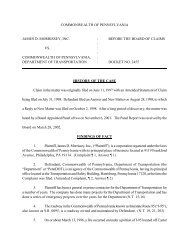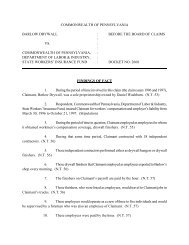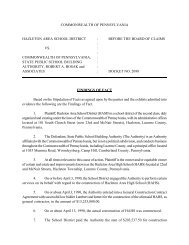3720 - Board of Claims
3720 - Board of Claims
3720 - Board of Claims
You also want an ePaper? Increase the reach of your titles
YUMPU automatically turns print PDFs into web optimized ePapers that Google loves.
section at a time contemplated by the Contract’s Construction Sequence. These actions by<br />
PennDOT were material changes to the Contract which actively interfered with Intercounty’s<br />
work and resulted in delay and lost productivity on the Project.<br />
Delayed Response to Design Problem<br />
Although PennDOT's active interference with Intercounty's work by way <strong>of</strong>: A) its<br />
misrepresentation that it would coordinate pole relocation at the start <strong>of</strong> the Project and its abject<br />
failure even to attempt to do so for the first six months <strong>of</strong> the Project and B) Mr. Sebastianelli’s<br />
unilateral dictates to Intercounty to abandon the Construction Sequence and work less productively<br />
due to the pole relocation problem rather than demobilize, were both material causes <strong>of</strong> the delay<br />
and disruption experienced by Intercounty on the Project, we find that PennDOT's initial design<br />
mistake (i.e. its failure to properly coordinate with the Utilities in the pre-Contract design phase<br />
and allow enough space in the right-<strong>of</strong>-way for the guy wires for certain <strong>of</strong> the utility poles in<br />
Section Two) and the nearly seven month delay in resolving this problem were even more<br />
significant causes <strong>of</strong> delay in relocating the utility poles and, in turn, the fundamental cause <strong>of</strong><br />
delay and disruption to Intercounty’s work on the Project. (N.T. 64-68). To begin with, we note<br />
that the guy wire problem itself was one <strong>of</strong> PennDOT’s own making. That is to say, even if it was<br />
the Utilities’ initial failure to identify guy wires for those certain poles at issue, it was PennDOT’s<br />
ultimate responsibility to authorize and approve the locations <strong>of</strong> the new poles and to properly<br />
situate them within its roadway design to allow the Project to be built as set forth in its plans and<br />
damages. (N.T. 58-69). 408 Specifications § 104.01; United States v. Spearin, 248 U.S. 132, 137,<br />
39 S. Ct. 59, 61 (1918); Canuso v. City <strong>of</strong> Philadelphia, 192 A. 133, 136 (Pa. 1937); A.G. Cullen<br />
Construction, 898 A.2d at 1160; Department <strong>of</strong> Transportation v. W.P. Dickerson & Son, Inc., 400<br />
A.2d 930, 932 (Pa. Cmwlth. 1979); Allentown Supply Corp. v. Stryer, 195 A.2d 274, 279 (Pa.<br />
84






